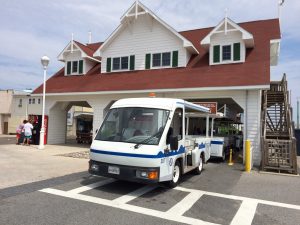
OCEAN CITY — Resort officials this week moved closer to resolution on the Boardwalk tram issue after approving a dual Request for Proposal (RFP) to explore options and benefits for both gasoline and electric replacements.
For the last several months, the Transportation Committee and city staff have been exploring options for repairing or replacing the city’s fleet of Boardwalk trams that are nearing the end of their useful life. From the beginning, all options have been on the table from refurbishing the existing trams used on the Boardwalk and at Winterfest of Lights, for example, or replacing them with new gasoline-powered or electric-powered options. Each option comes with its own benefit and a wide price range.
Through the committee and task force meetings, it was determined refurbishing the eight Boardwalk trams was not a viable option for a lot of reasons, not the least of which was a check with the current trams’ manufacturer revealed a long list of obsolete parts that would no longer be available. In addition, the eight trams would need to be resurfaced and repainted and there are concerns about what rust or other damage might be revealed on the substructures when the bodies were taken off. In addition, six of the trams are used during Winterfest of Lights, so only two could be refurbished in any one year.
That essentially left two options on the table including new gasoline-powered trams or new electric trams. Diesel had already been taken out of consideration because of concerns about exhaust and fumes on the Boardwalk. On Tuesday, Public Works Director Hal Adkins and Procurement Manager Catrice Parsons presented the Mayor and Council with a request to prepare and release an RFP seeking proposals for both the gas and electric options.
The council unanimously approved the requested RFP, which does not commit them to either option but mere solicits more specific information on both potential options.
“From an administrative standpoint, it is our desire to do the RFP on both gasoline and electric,” said Adkins. “You’re not obligating yourself to anything. This will position you to see what all of the options are and what the costs might be.”
According to the research, both options have different benefits and price tags. For example, replacing the eight trams including the motor unit and the passenger cars with electric could cost as much as $4 million, while replacing the trams with gasoline units could cost about half of that.
However, Parsons explained the RFP would allow the Mayor and Council to make the best decision on a variety of factors and not cost alone.
“It’s not based on cost entirely,” she said. “Electric trams could be considerable more, but there could be other gains to consider in the long run. We won’t know until we get the bids. It would be based on the best value and cost would only be a small percentage. Cost alone would not be the deciding factor. It would be a value-based procurement.”
Adkins agreed there were different benefits associated with each option, but also said the expectation is that electric trams would be considerably higher in price.
“This two-pronged approach to the RFP will position you to see what the cost might be for eight electric trams,” he said. “It is our assumption based on previous discussions with the vendors that the number may very well be around the $4 million mark. A decision will have to be made on the cost versus the value of going green.”
There are long-term advantages to electric trams, however. For example, they would be charged by batteries with a 10-year useful life and an estimated annual cost of charging at around $5,000 each for the eight trams. The electric trams would also result in minimal maintenance and labor costs compared to the gasoline trams.
In addition, the electric models under consideration have capacity for 80 passengers, while the gas-powered trams have capacity for 69 passengers. From an environmental and visitor experience standpoint, the electric trams would have zero tailpipe emissions and the only noise created would be the tires on the Boardwalk.
By comparison, the gas-powered option comes in considerably lower in upfront costs, but has higher long-term fuel, maintenance and labor costs. The gas-powered trams would have an estimated five-year average $23,900 cost for fuel. The 10-year estimate for gas-powered trams for fuel, maintenance and parts comes in at $939,000 compared to the estimated $250,000 for the electric trams.
Adkins explained the current tram storage and maintenance facility at 2nd Street currently under development could be easily altered to accommodate either option. In addition, in response to a question about going back to the old method of Jeeps or other vehicles towing the tram passenger cars, Adkins said that would essentially mean customizing the trams and create an even higher price tag.
After considerable debate, the council voted unanimously to have the procurement department send out the RFP for both the electric and gasoline options in a sort of fact-finding mission to help determine the costs of both. The RFP is not a commitment to either option, but merely exploratory to help make the decision easier.

